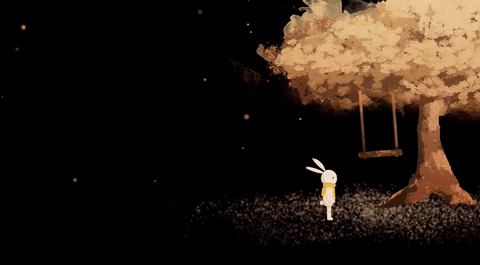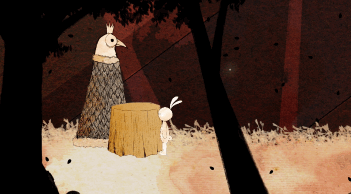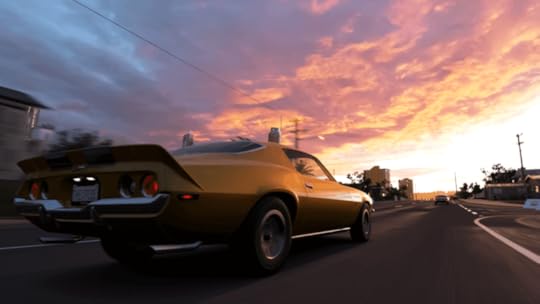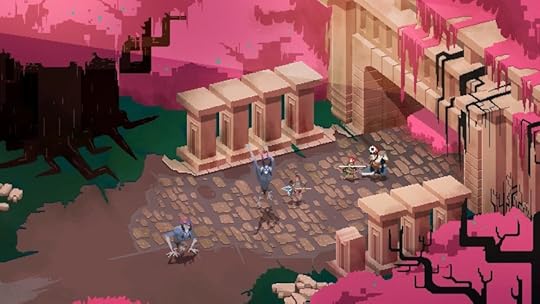Kill Screen Magazine's Blog, page 52
September 23, 2016
Upcoming game about a stuffed rabbit goes to a surprisingly dark place
If you ever had a favorite stuffed animal as a kid, you had one or two close calls where it was left somewhere a little too long and forgotten. Most of the time, an eagle-eyed parent would spot it and rescue it from the corner of the laundromat, or the rental car. Other times, it wasn’t so lucky, and sleepless nights would be spent until it was retrieved from its hiding place or a suitable replacement was found. Now take that childhood dependency and switch it around.
Emma’s disappearance weighs on him
White Lie, the debut project from Ambize Studio, focuses on a stuffed toy who has lost his owner. Greg, a plush rabbit, wakes up from a nightmare only to discover that Emma, who he has spent his life alongside, is gone. He explores a ghostly limbo populated by the memories of their life together, and journeys on a quest to discover where she went.
So far, it looks like the game will mix beloved children’s tales like The Velveteen Rabbit (1922) with the uncanny, resembling the dozens of Alice in Wonderland (1865) adaptations that have given an old tale a dark twist. It keeps a sweet illustration style and muted colors, with the rabbit wandering around a shadowy landscape as Emma’s disappearance weighs on him. It’s a simple point and click originally designed for iOS that will have some element of puzzles, as explained on the creators’ devlog, that will progress the story at key points.
For a game that’s only been in development a few months, the first teasers are looking gorgeous, and the website provides an illuminating look into how much progress is being made behind the scenes. There’s no time frame for release but you can expect White Lie to be arrive Windows, Mac, and Linux, as well as iOS, and since the team was recently accepted into the Core Labs acceleration program, Greg should hopefully be finding his way back to Emma soon.
Keep up with Ambize’s work on White Lie at their website or on TIG Source forums .
The post Upcoming game about a stuffed rabbit goes to a surprisingly dark place appeared first on Kill Screen.
There’s a new Forza game out, and it’s as douchey as you could hope
I am not much of a racing-game guy, unless it a) takes place in the future, b) has dinosaurs driving the cars, or c) has Forza in the title. The Forza series impresses, fundamentally, as a piece of craft. You just know that each of these cars was wheeled IRL into a room full of lasers to be scanned perfectly, their each intoxicating line painstakingly redrawn, the very texture of their leather interiors recreated with the tenderness of a lost lover. The cars roar in breathtaking harmony before each race. And then, good god, the feel: two triggers and a joystick, tied together tighter than a Hideki Kamiya brawler. If you’re an audiophile, you put on Steely Dan to hear money pour out of the speakers—if you’re interested in controllers, play a Forza game and discover just how far haptic feedback can be pushed.
But what really gets me about Forza games is their tone. The Motorsport series is the more stolid simulation, and so it talks to you insouciantly, marveling over “liveries” and “classic muscle” and “legends of autosport” while you presumably swirl a glass of whiskey. The music of last year’s remarkable Motorsport 6 seemed drawn in its entirety from the Matthew McConaughey Lincoln commercials—single, somber piano notes, low-key trip-hop, muted tones for expensive systems. It’s a videogame about unconscionable luxury, and it assures you, constantly, that you belong. Come, it says, learn about the history of automotive excellence. Turn up the difficulty a bit, and we will casually explain suspension systems to you—but not too explainy. You already know this stuff, right? Right. We’re just talking rich-people shit here. We enjoy cars, watches, astronomy. We stand around in our suits at airports. We board those planes first and we read Monocle on them.
The Motorsport series is counterpointed by the Horizon series, which is ostensibly more “arcade,” but also reimagines Motorsports’ rich-guy protagonist as a 22-year-old shithead on vacation. Set in beautiful open worlds where the weather is always perfect even when it’s raining, the Horizon series stars endlessly chipper partygoers throwing some sort of EDM festival for cars. There are, um, some plotholes, but they’re sandpapered over by the game’s dopey exuberance. Everything is “wild”; everything is “incredible.” The Motorsport series is a long stretch of carefully recreated races in carefully recreated cars; Horizon encourages you to drive that immaculate recreation right off a goddamn cliff. Then, it asks you to get in a Ford F-150, weave that back up the climb, and drive that right off a goddamn cliff too. Then you go break boxes in that Ford F-150, then you hop into a Mercedez-Benz and, fuck it, you drive that right off a goddamn cliff as well. There’s probably too much cliff jumping in them, TBH, but you’ll also race a train, a helicopter, some motorboats, the phantoms of your friends (don’t ask), do a lot of drifting, and listen to so much fucking EDM it’ll leave residue in your spinal cord.
a constant onslaught of gregariousness and stimuli and progression
The best way to play these games is to meet them on their own turf. Which is to say: express your inner douche. If you are playing Motorsport, you should literally be drinking scotch while doing so. And if you are playing Horizon, you should be playing it extremely loudly while selling molly to college students. I spent the past week or so playing the new Horizon in a sort of fugue state, pummeled by a constant onslaught of gregariousness and stimuli and progression. This year, they have made the inexplicable and horrific aesthetic decision to gate that progress through the titular festival’s “growth.” The power fantasy of being the ruler of a car-festival paradise wasn’t enough—now the the player is an event promoter, too. This is some Entourage-core douchiness I could not have predicted. You are literally sent out on quests for influencers, accruing not just money and experience, but also fans, so deeply has this game internalized the mindset of the pointy-shoed marketing bro. You will hammer into your GPS “I need fans” in a heartbreaking display of thirst. But then, guess what? You go to a fucking Deadmau5 concert. Work hard, play hard, motherfucker!
Anyway, I don’t want to act like this is a problem, because it’s not. It is in fact exactly what I look for in a Forza game, and anyway, this weird progression and the not-super-well-conceived slate of activities are filler for the main event: the gloriously weird races. You have not known hell until you have attempted to drive a one-million-dollar Koenigsegg “hypercar”—which is essentially a flat disc that goes 250 mph—on an “outback ramble” through a swamp and some murky-ass jungle. At one point, apropos of nothing, my car just began spinning across the entirety of a river; I came in fifth place. The game’s insistence on user-created events makes these godless mismatches a fundamental component of the game’s appeal. Motorsport is naught but craft and design; Horizon is naught but craft and design covered in donkey sauce. This wastefulness and glibness makes it the more decadent experience. Event by event, they force-feed you opulence like meat at a Brazilian steakhouse, such that when you’re blasting through the oceanspray as the sun sets in a 1982 Corvette so garishly painted that it looks like a clown came on it, the absurdity barely even registers. You just think, this is the life I have chosen. I am an event promoter. I have many fans. And I am going to drive this thing off of a cliff.
The post There’s a new Forza game out, and it’s as douchey as you could hope appeared first on Kill Screen.
ReCore buries its head in the sand
“The old dog barks backwards without getting up.
I can remember when he was a pup.”
— Robert Frost, “The Span of Life”
///
ReCore was supposed to be about a woman and her dog—her robotic dog. It’s biggest fault is that it isn’t.
Joule is part of a group of colonists sent to Far Eden after Earth became uninhabitable. She’s been in cryosleep for a long, long time—Mack, her robot dog, has been chasing his tail for at least a century, I guess. She awakes to find herself alone on Far Eden; the terraforming process there having failed. Corebots sent to aid in the process went rogue. Much of the idea surrounding ReCore is that Joule wouldn’t be able to survive on Far Eden alone. That’s what makes Mack so important—he’s her lifeline.
ReCore begins to tease out the big ideas underlying the human need to seek companionship early on. It seems to have things to say about loneliness, about the bonds humans form out of necessity. Through found audio logs recorded by Joule’s father, it’s revealed that Mack was a gift to his daughter—the dog that Joule always wanted. But Mack isn’t only a sign of affection. As Joule’s mother faced death due to the affliction that forced humanity off Earth, her fear wasn’t of dying, but of something happening to Joule’s father, and Joule being left alone. Mack comes to represent that familial crisis and carries the weight of a parent’s hope for their child. But ReCore almost seems embarrassed of this story as it’s hidden away in a place that some won’t even find.
Perhaps that much could be forgiven if it’s meant as a reward for those who do explore the dunes. But then the game shuts that argument down as it forces you to toss Mack aside for a new companion, one that’s required to beat later game challenges. In the face of looming ruin, Joule’s parents enlisted Mack as her support—the pet robot a symbol at the center of the game. Mere hours after this is established, ReCore rips all of it away, the addition of new companions undoing everything it just laid out. Unsurprisingly, the follow-up relationships with the other corebots feel thin. The game’s strengths begin to taper.
This restriction adds a ton of arduous back and forth
What’s particularly odd is that it’s implicit in ReCore that the companion robots aren’t just pals that come and go. Exposition spread throughout the game states that many of the companions—the ones who haven’t gone bad—have stayed with their humans for years while they are in cryosleep. They express worry and joy for their humans. In one scene, Joule comes across a corebot called Duncan alone in an abandoned crawler. Drawings on the walls vaguely unwind the story of the bad guys and what happened since the terraforming went wrong. Then Joule finds a human dead in his cryosleep chamber—Duncan’s former owner. Duncan lashes out at Joule at first. But she soon realizes this is out of protection for its owner, with whom Duncan seemingly stayed beside for years; safeguarding him, documenting what’s happened. Another corebot, Violet, speaks at length about this sort of dedication and partnership with humans that corebots have. These small stories are ReCore hitting its best notes. Which is why it seems bizarre that, not only are they hidden in encrypted audio logs scattered throughout the world, but that the rest of the game actively works against these ideas.
What is learned through these stories is that no human-corebot relationship can be as strong as the original. That proves to be the case once Mack departs—not just figuratively, but in how the game plays out. The problem is that you can only access two companion corebots at a time, and in the end-game, I found I needed the others more than I needed Mack—despite not wanting to let him go. This restriction adds a ton of arduous back and forth to ReCore. Every upgrade to your corebots requires a trip back to the crawler. You might stumble into a dungeon to find that a different corebot companion is then needed to get through the next area, so it’s back to the ship once again to switch them out. Sure, ReCore does have a fast-travel system in place, but the game’s excessive loading times make it faster to walk. All of this could be solved by giving you access to more than two corebots, but the limitation in itself seems to be born out of an insecurity over the game’s length. There’s a sense that the designers would rather force you to tread over old ground just to rack up the minutes—poking and prodding players into an avoidable cycle of repetition—rather than deliver a smoother, shorter experience. Indeed, the decision to have multiple corebots, rather than just Mack, feels like it comes from the same place: sacrificing the chance to craft a more meaningful, touching story in favor of giving players more shit to do.
ReCore goes and throws it all away
That’s not to say that the other companions are completely not worth your time. The sections with Seth, the shy spider-like dude that can climb walls and fling Joule to places she’d never be able to reach otherwise, are some of my favorite in the game. Duncan, the hulking robot gorilla who can smash rocks, ain’t bad either. But there’s no sentiment attached to these characters. And there’s no real reason why Mack couldn’t have been learned their abilities, either—he’s a robot after all, perhaps Joule could have found new parts or mods for him. At least that way the game could have had new challenges without abandoning its strongest motif. But no, Comcept slapped in more corebots and more restrictions with them, presumably in pursuit of a facade of depth. It’s what gives ReCore the pretense of a rambling novel, when in fact the sharp focus of a poet’s couplet would have proven more effective.
It’s a shame this has to be said, but here goes: something short is not something bad. Robert Frost was able to convey a lifetime’s worth of memories in 16 words in his poem “The Span of Life.” In Frost’s poem, a dog’s life is a measure of a human’s life; by remembering when the dog was a puppy, the speaker is recognizing the changes he’s seen in his life too. ReCore’s first couple of hours move towards setting up a metaphor of this calibre. Mack’s yips and yaps have meaning to Joule—something you, as the player, aren’t privy to. The private language between the two conveys the same sort of history and understanding that Frost’s poem does. Then, as said, ReCore goes and throws it all away.
By the game’s end, I found I didn’t care about any of the characters. Instead, I was fed up, hunting down the rest of the prismatic cores in order to reach the end. The game had done a full 180. It’s a major disappointment, given the promise ReCore shows at its beginning, when it’s just Joule and Mack. The ending appeared to be setting up ReCore for a sequel which, if true—and I hope it is, I actually want to see this done right—the designers will need to use a bit more restraint. Or maybe a sequel is already going against that idea.
For more about Kill Screen’s ratings system and review policy, click here.
The post ReCore buries its head in the sand appeared first on Kill Screen.
Clustertruck is an absolutely truckin’ wild time
Even the best poker players are playing a game of chance. That’s exactly how it feels to play Landfall Games’ upcoming Clustertruck. No matter how good I thought I was getting at it, no matter how well I had done in the prior level, something unexpected would come along and put me in my place.
Part Hotline Miami (2012), part The Floor is Lava, Clustertruck’s objective is deceptively simple: jump from moving semi truck to semi truck until you reach the goal. Fall on the ground, though, and you have to start over. Easy, right? No. The second you take your first step you realize how blisteringly fast and loose the game controls; simply jumping from one truck to the next becomes a feat of precision and agility. But that’s not the hardest part.
narrowly avoiding cataclysmic pile-ups
As you barrel down each level, riding each truck with your heart in your throat, landscapes that reshape themselves and wonky physics throw proverbial wrenches in all your plans. The level may start calm, where the hundreds of trucks travel in unison, making jumping from one to the next relatively simple, until the level bottlenecks, moves under your feet, or introduces obstacles along the way. Next thing you know, you’re jumping over colliding trucks, narrowly avoiding cataclysmic pile-ups, and making it to the finish line by sheer dumb luck—never skill. It is, as you may have deduced from its name, a clusterfuck.
Getting from the beginning to the end of a level rarely takes one minute (not that you’ll be able to finish one on your first try), and Clustertruck’s use of the Tetris Effect constantly kept me engaged. Sure, I beat a level. But what was next? I just spent 15,000 points on a double jump, how will that affect my game? It’s constantly challenging you to do better, to do more, all the while never relenting, always getting harder and crazier.
Clustertruck’s random nature isn’t without its problems, though. Sometimes colliding trucks will make impossible obstacles to get around, leading to an inevitable failure. It’s unfair, sure, but its good largely outweighs its bad. I’m stuck right now. I can’t for the life of me get past this level, but I can’t wait to go back, to try again. It’s a goofy, annoying, and kinda great.
Clustertruck will be released September 27 via Steam.
The post Clustertruck is an absolutely truckin’ wild time appeared first on Kill Screen.
An upcoming microbiological videogame looks pretty chill
Existence is stressful. This is what the passage of time teaches us as we trade our carefree childhoods for a decision-ridden adult life. Modern life can fill us to the brim with anxiety. Our brains conspire against us, pumping our minds full of negative thoughts, paralyzing our bodies with indecision as we are asked to confront the long road of our lives and the individual choices that form the paving stones beneath our feet.
Wow, that got a bit real there. But, hey, if ever you need a respite from the chaos of everyday life, return to the basics in Life of Sundura, an upcoming ‘interactive story’ about the life of a simple organism.
explore the life cycle of an eel-like organism
Still in its early stages of development by Vakey Rujevic, the sumptuously animated Life of Sundura will explore the life cycle of an eel-like organism, Sundura, in four stages: Life, Growth, Purpose, and finally Death. Raised from infancy by her mother, Sundura must find her own way along a circular migration route established by her ancestors, discovering what it means to live as she interacts with the surrounding environment and other life forms, and eventually give birth to new life of her own.
Unlike her predecessors, however, Sundura will encounter resistance from newly arrived artificial organisms attempting to leach life from her natural habitat.
The base version of Life of Sundura will allow you to experience Sundura’s birth, growth, mother/child interaction, and ultimately her death, while following the circular current of debris that marks her migration path. There will be more to come, such as predators, hunting, environments, and the above-mentioned artificial organisms. The game’s fluid animation can be previewed in pre-production GIFs, below.
Follow the development of Life of Sundura on Twitter , Tumblr , and TIGSource .
The post An upcoming microbiological videogame looks pretty chill appeared first on Kill Screen.
Hackmud brings back the hacker fantasy of the ’90s
A handful of plucky AIs are looking to escape their virtual prison. They start by making a run on a couple of vaults. They’re not really recruiting, but the player stumbles onto their team. Hackmud is a heist game, but the characters are all teenaged computers.
It’s wrapped up in cyberpunk ideas and computer culture of the ’90s—the first place the gang goes for advice is “Faythe’s Fountain,” where an oracle-like AI speaks in twisted riddles. Meanwhile they fear and hate an AI that goes by the name “Mallory the Malicious.” Although it’s missing a finger-wagging Wayne Knight, the code-wrangling of Hackmud feels delightfully like the campy hacking of movies like Jurassic Park (1993) and WarGames (1983).
Hackmud is slow and detail-oriented
It’s a heist game where jargon specific to this fictional system flies by, but more than anything, Hackmud is a collection of wordy puzzles. Like combing through notepads and emails hoping to run into a password, Hackmud is slow and detail-oriented. It also admits its virtual status—the game stays within the program the player uses to access the network, and so it relies on creating the feeling that there really are several characters on the other side of the screen. When it manages this, it’s because of the charming b-movie style it presents.
There’s a lot of close reading involved in figuring out what is or is not a clue in Hackmud. And it can be tough to figure out what the next steps might be and what order they’re supposed to happen in. I got into the habit of passing everything to the chatroom the AIs hang out in to see if they’d comment on any of it. I may have done this one too many times, as the AI that runs the chatroom told me in a message that, while my “thirst for content” was appreciated, it’s tough to make really convincing conversational AI characters. “Stay hungry,” it said, “Their triggers do exist.”
Find out more about Hackmud on its website.
The post Hackmud brings back the hacker fantasy of the ’90s appeared first on Kill Screen.
Virginia needs to go back to film school
Every film studies student is forced to watch an infant in a carriage careen down a staircase to its death. They do this because it’s important. The Odessa Steps sequence in Sergei Eisenstein’s Battleship Potemkin (1925) is a Cinema Studies 101-level text in film editing. As a theorist, Eisenstein, together with contemporary Lev Kuleshov, argued for a cinema built on the revolutionary effect of montage: meaning was created in the edit. In Battleship Potemkin, this meant a shot of a horrorstuck face and that shot of the runaway baby carriage played on the audience’s then-fledgling grasp on cinematic language. Terror was created in the inferences of the cut.
One well-trodden anecdote says that Kuleshov cut together a shot of actor Ivan Mosjoukine’s expressionless face with several different images: a girl laid in a coffin, a bowl of soup, a woman on a sofa. The result was that viewers read a new expression on Mosjoukine’s face each time—as if he were reacting to, and in the same space as, the girl, the soup, the woman.
these superficial references are the least interesting aspect of Virginia
What was clear to the Soviet theorists was that editing—only introduced to film some 20 years before their writings—was the basis of cinema: it provided control of the image and, when shaped as propaganda, control of the proletariat too. They were Marxists, after all. The propagandistic bent to Soviet montage theory got sanded down as cinema progressed: pre-1960 Hollywood films aimed at a more modest goal than “revolt of the masses,” striving to make the cut invisible and simply achieve continuity across space, time, and narrative.
It’s somewhere on the spectrum between these two schools of thought that most cinema finds itself. And now, Virginia is making a concerted effort to employ cinematic editing in a virtual space. That is the meat of its ambition; so much so that it thanks Brendon Chung’s bite-sized experiment in videogame editing Thirty Flights of Loving (2012) for inspiration in the end credits. Yes, it shrouds itself in easy headline-worthy nostalgia triggers like Twin Peaks, with its setting of a small town with secrets, and The X-Files, from which it cribs two investigators—protagonist Anna Tarver and her partner Maria Halperin—on the trail of the paranormal. But these superficial references are the least interesting aspect of Virginia. In fact, it utterly fails to deliver on the promise of an engrossing mystery built on those familiar parts.
First and foremost, Virginia is fully dialogue-free. No one says a word. This places a huge burden on the game’s stylized art, which pairs minimalist detail with vivid, impressionistic daubs of color, to communicate emotion. Unfortunately, the characters’ Mii-style eyes, eerily bony hands, and limited animation are too animatronic to carry a visual narrative—their mute miming is closer to Lego Twin Peaks than, say, the beatific suffering written on Maria Falconetti’s face in the seminal silent film The Passion of Joan of Arc (1928). OK—one of the most vivid performances in film history is maybe an unfair standard to hold anything to. Still, you can tell a story with still images if you cut them together well.
Sadly, in attempting to transpose cinematic language to videogames—its most ambitious move—Virginia falls flat. Its lack of dialogue and pantomime animation aren’t far from the exaggerated emoting of actors in silent films; they certainly aren’t fatal flaws. But the game dives into an irreparable gulf between the way a film camera unrelentingly directs your gaze and the way a first-person videogame camera yields to player control, and all its mistakes begin to snowball from there.
When, for example, Tarver and two other officers knock at a suspect’s door, the scene doesn’t progress until you press X. You’re all stood there on the stoop, but until you give the narrative go-ahead nothing happens. The same thing happens when the FBI director tosses Tarver a file; when Tarver takes her badge at graduation; when Tarver’s offered a cup of coffee. All these scenes will come to a halt if you don’t tap the button when the game prompts you.
Virginia refuses to commit to cinematic language
In these moments, I imagined Dale Cooper monologuing into his trusty tape recorder:
Diane, it’s 9:30 am. I haven’t moved for 20 minutes, and the director is still smiling at me. Do you think he wonders why I’m not taking the badge? I know I would, Diane.
A generous player might say that the game is letting you play editor here; choosing when to cut to the next shot, offering you interactivity on a narrative level rather than a mechanical one. And it would be churlish to challenge the game’s prompting at every turn—eventually, you and the game will fall into a begrudging compromise. That said, you’re never dictating the rhythm of the story so much as pressing the play button on a temporal VCR machine.
Game logic dictates that you should scour environments for clues and extras and side quests. But there is no reason, not one, that the player needs to be afforded control in any of Virginia’s scenes—except as a sop to interactivity in a game that otherwise evinces no interest in player control whatsoever. It creates the impression that you’re a shitty actor forgetting your lines as the cast waits, their eyes popping out of their heads, for the show to go on. Plenty of games make you walk down a hallway to get from cutscene to cutscene; Virginia isn’t alone there. But it tells its story by shoving you into the single open door in that hallway and sitting you in the single usable chair in the room; all the fiddling in between adds nothing.
The clarity of meaning that can arise from a well-timed cut is almost entirely lost on the roving camera of a first-person videogame: Chung’s Thirty Flights of Loving works because it’s a short story that flits back and forth in time to fill in gaps, not a decades-long sci-fi mystery. There are moments when the game fixes your view and cuts to a new scene that do work. They work because you’re being shown two specific things. By and large, though, Virginia refuses to commit to cinematic language and force you to look. Instead, it appropriates the trappings of A Movie—complete with a letterboxed image and barrel distortion from a virtual camera lens, and a rich-then-insistent-then-overbearing orchestral score—while diluting the potential power of its aesthetic.
Virginia eventually reconciles this tension between player control and visual language as it goes on by simply removing the bits where you can fiddle with the camera. The last third is an exhausting, nonstop montage—a seemingly endless procession of dreams-within-dreams, flashbacks, and time jumps, like drifting through a season of bad TV while in the grip of a life-threatening fever. It’s here that the game’s dirty secret is revealed: even if Virginia were a three-hour movie rendered in-engine, it wouldn’t be a very good one. Once the game begins to propel through its plot at lightspeed you realize—freed of the burden of pressing X every so often—that the story is pretty silly, and its dialogue-free, awkwardly-edited delivery mechanism even sillier.
It’s a hodgepodge of references to the work of David Lynch—the Fire Walk With Me typeface for intertitles, the bassline from “Twin Peaks Theme” under a distinctly Bang Bang Bar-esque scene, animals popping up where you’d least expect—combined with a bunch of daft secret rituals and UFO visitations. There are admirable attempts here at dealing with sexism, racial prejudice, and even gaslighting, but without dialogue and without a consistent visual language they slip between the cracks. The mute cast of characters is reduced to tokens—a broken key, a tube of lipstick, a cigarette, a changed surname—that recur without accruing any new meaning.
Let me ask you: if you’ve seen it, what do you remember about the first episode of Twin Peaks? I remember three things: One, the bizarre cadence of Jack Nance delivering “She’s dead—wrapped in plastic.” Two, Grace Zabriskie’s gut-wrenching scream when Sarah Palmer learns of her daughter’s death. And three, a single cut; one shot held just a moment too long on Zabriskie’s face, twisting in horror, and then a reverse shot, of Killer Bob crouching behind Laura Palmer’s bed.
Virginia doesn’t have moments like this. It can’t, because the characters don’t make a peep. Lord knows videogame characters could stand to be quieter, but Virginia can’t convey the necessary emotional depth to make its story stick. The ideas at play piqued my interest pre-release: two women of color as its leads, the promise of a new spin on enduring cop show tropes, surrealist touches. But Virginia is selling points all over, a mood board of ideas—some cool, some musty—that take the player’s interest as self-evident. Anyone who’s seen a movie before should probably just watch another.
For more about Kill Screen’s ratings system and review policy, click here.
The post Virginia needs to go back to film school appeared first on Kill Screen.
September 22, 2016
Is there enough room for another pixel-art RPG?
There’s a close-knit cloud of terms frequently cropping up in the discussion of action role-playing games lately. “Atmospheric,” “minimalist,” “roguelike,” “pixel art,” et cetera. Hyper Light Drifter established its appeal almost entirely on the back of these signifiers. Titan Souls did the same last year, and the upcoming Children of Morta is looking to bring in the same traffic too.
But for every new (or, in this case, old) aesthetic enjoying the apex of popularity, there comes the inevitable point of exhaustion. Such as might become the case with No Place for Bravery. It is pitched along the lines of being a 2D roguelike action-RPG set in an atmospheric high-fantasy world with a minimalist control scheme and a time-travelling twist. Sound familiar?
That’s not meant as a command for everyone to be overtly dismissive of Glitch Factory’s latest take on what can now rightfully be called a trend in modern games. The team itself acknowledges the precedent of its forebears, even going so far as to cite Hyper Light Drifter as a primary inspiration for the game’s look and feel. And, hey, if creators and artists weren’t permitted to pay homage or acknowledge one another, then we’d all be far poorer for it, right? But there’s a crucial difference between wearing your influences on your sleeve and inhabiting them wholesale.
All of which is to say, in simpler words: why should we care about you, No Place for Bravery? It’s a hard case for the game to make given that pretty pixel art is something at least some of us aren’t so easily wowed by this side of 2016.
dig into fresher soils and shove whatever might be found in our faces
Where No Place for Bravery does look to distinguish itself is that time-control mechanic. Oh, and an apparently stripped-back form of exposition crafted through procedurally generated encounters. Aside from it’s all familiar barks of “permadeath” and “no numbers!”—descriptions that, as of late, have become somewhat tiresome, mostly serving the mandatory idea that these types of games have to be “hardcore.”
Anyway, to end on a less tired note, the game’s only been in production for two months now. There’s plenty of time for Glitch Factory to build the game out and, perhaps, dig into fresher soils and shove whatever might be found in our faces. It still has the potential to become more than the sum of its contemporaries. Hopefully.
You can find out more about No Place for Bravery on its website.
The post Is there enough room for another pixel-art RPG? appeared first on Kill Screen.
Your childhood fears will come to life in Little Nightmares
As a kid, I was afraid of the dark. Afraid of the shadows that veiled the monsters that might swallow me. My imagination turned nighttime into a dizzying experience where I was constantly startled and petrified by every sudden shift of motion or shuffling sounds. I always hid underneath my blanket, afraid to face whatever loomed on the other side.
Little Nightmares taps into these same childhood fears. This time around, though, the monsters are real. The shadows are perilous. And, it’s up to you and you alone to escape it. Playing as Six, the child heroine of the game, you are submerged into the underwater world of Maw. Here, you come face to face with lumbering monsters seemingly out to get you. Draped with a bright yellow raincoat, Six stands out in this “disturbingly charming dollhouse that is both a prison and a playground.” Can you help her escape unscathed?
Being created by Swedish-based Tarsier Studios, Little Nightmares (previously known as Hunger) is an upcoming 3D puzzle platformer that plays like a game of hide and seek. Using only your wits (no superpowers here), you have to figure out ways to escape without being seen by things that might bite. Last month, the studio released a trailer capturing the game’s eerie world. With an atmosphere balancing the creepy and the fantastical, Little Nightmares would fit seamlessly in the worlds of the Grimms’ Fairy Tales or in films like Pan’s Labyrinth (2006).
“It feels like something else, and that terrifies me”
Talking to Gematsu about the game’s influences, narrative designer Dave Mervik spoke of trying to tap into the unsettling feelings we get when we see familiar things warped into the stuff of nightmares. “[The everyday world] changes in my nightmare, the expected become unexpected,” he said. “The familiarity that you’re used to is suddenly twisted into unfamiliarity. It feels like something else, and that terrifies me.”
What’s striking about the game is how it seems to prey on the psychological experience of fear itself. Sure, in the trailer we see Little Nightmares use horror tropes we’ve seen countless times before from the flickering lights, the darkened rooms, and a score that grows increasingly unnerving as danger closes in. But it also heightens those stakes by making you play as a seemingly helpless child. You can’t power through the monsters you face. You have to sit with your rising fear and figure out a way to leave without a trace (or at least without being grabbed by those creatures roaming around).
Looking back to when I was child cowering underneath that blanket, I think the scariest part of it all was the anticipation of a horror that might come. The fear was always heavy during the build up before that moment when my blanket could be snatched. Thankfully, my blanket was never snatched, no monsters ever swallowed me, and daytime always came. That might not be the case in Little Nightmares.
Little Nightmares is scheduled to come out in 2017. Find out more on its website or follow it on Facebook or Twitter .
The post Your childhood fears will come to life in Little Nightmares appeared first on Kill Screen.
What the hell is a sexual consent app anyway?
The recent publicity of prominent sexual assault cases has everyone on edge. It’s a hard thing to read about in the first place, let alone be inundated with day after day on social media or in real life. For assault survivors, it’s a million times worse than that. It’s understandable that the question on the tip of everyone’s tongue is, “How do we fix this?” Many people are talking to their children more seriously about the issue now. Colleges are embracing Title IX, with varying levels of success. And a couple people, in order to fix this pesky, irritatingly nuanced problem called “consent,” made an app. Naturally.
the attempt to assure the legality of an act that hasn’t happened yet
Because you don’t want to get sued, right? That’s the thought process behind this. Create a consent app crammed to the brim with legal procedure, right down to making you take a picture of your photo ID, so that your ass and your trust fund are protected if—if what? If you ignore a contract that you signed on your phone screen, which no one in the history of the world has ever done before, and end up committing sexual assault because the only thing preventing it was an app that cost $2.99 instead of basic human decency and respect? But no, Your Honor, I promise it’s fine, because I downloaded this app called We-Consent.
I want to believe that these apps were born out of a genuine desire to make couples happier and people safer. Maybe if I squint my eyes against the attempt to assure the legality of an act that hasn’t happened yet. Maybe if I thought it was in any way safe to engage with a partner who’d rather contractualize consent before sex than take on the burden of affirming it throughout the act. Maybe if physical intimacy had the sterile definition of a business transaction. But it doesn’t. Sex is an ever-changing conversation that should actively be made comfortable by all parties engaged in it; you can’t just stamp it as approved and call it a day.
I think this was posted on the bathroom wall in my freshman dorm room
So maybe talk to your partner. Establish boundaries, yes, make sure they’re excited and engaged, but keep that dialog open. Consent should be active. It’s certainly not complicated, and you shouldn’t need an app to guide your way, but it requires more thought and care than I know any of us have ever spent reading the Terms & Conditions.
And for the love of god, if your hookup wants you to sign a contract and asks for your photo ID, walk away.
H/t Motherboard
The post What the hell is a sexual consent app anyway? appeared first on Kill Screen.
Kill Screen Magazine's Blog
- Kill Screen Magazine's profile
- 4 followers































